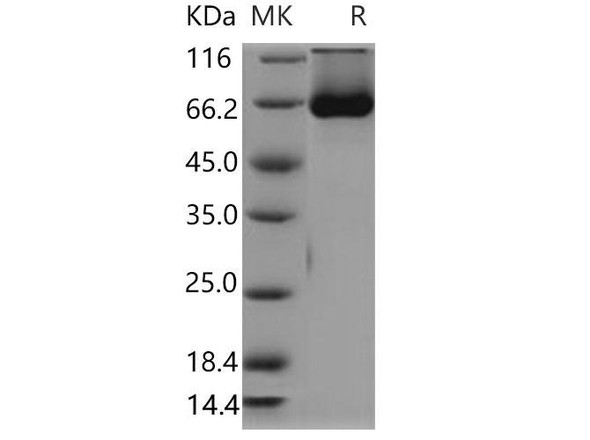Description
| Product Name: | Human PTPN11 Recombinant Protein |
| Product Code: | RPPB2644 |
| Size: | 10µg |
| Species: | Human |
| Target: | PTPN11 |
| Synonyms: | Protein Tyrosine Phosphatase, Non-Receptor Type 11, Protein-Tyrosine Phosphatase 1D, Protein-Tyrosine Phosphatase 2C, EC 3.1.3.48, SH-PTP2, SH-PTP3, PTP-1D, PTP-2C, PTP2C, SHP2, Tyrosine-Protein Phosphatase Non-Receptor Type 11, Noonan Syndrome 1, METCDS, SHPTP2, BPTP3, SHP-2, JMML, NS1, CFC, PTPN11.��� � � ��� � � � � � � � � |
| Source: | Sf9 Insect cells |
| Physical Appearance: | Sterile Filtered colorless solution. |
| Formulation: | PTPN11 protein solution (0.5mg/ml) contains Phosphate Buffered Saline (pH 7.4) and 10% glycerol. |
| Stability: | Store at 4°C if entire vial will be used within 2-4 weeks. Store, frozen at -20°C for longer periods of time.�For long term storage it is recommended to add a carrier protein (0.1% HSA or BSA).�Avoid multiple freeze-thaw cycles. |
| Purity: | Greater than 90.0% as determined by SDS-PAGE. |
| Amino Acid Sequence: | ADPMTSRRWF HPNITGVEAE NLLLTRGVDG SFLARPSKSN PGDFTLSVRR NGAVTHIKIQ NTGDYYDLYG GEKFATLAEL VQYYMEHHGQ LKEKNGDVIE LKYPLNCADP TSERWFHGHL SGKEAEKLLT EKGKHGSFLV RESQSHPGDF VLSVRTGDDK GESNDGKSKV THVMIRCQEL KYDVGGGERF DSLTDLVEHY KKNPMVETLG TVLQLKQPLN TTRINAAEIE SRVRELSKLA ETTDKVKQGF WEEFETLQQQ ECKLLYSRKE GQRQENKNKN RYKNILPFDH TRVVLHDGDP NEPVSDYINA NIIMPEFETK CNNSKPKKSY IATQGCLQNT VNDFWRMVFQ ENSRVIVMTT KEVERGKSKC VKYWPDEYAL KEYGVMRVRN VKESAAHDYT LRELKLSKVG QGNTERTVWQ YHFRTWPDHG VPSDPGGVLD FLEEVHHKQE SIMDAGPVVV HCRHHHHHH |
Astyrosine-protein phosphatase non-receptor type 11 isoform 2 (PTPN11), is a member of the protein-tyrosine phosphatase family, non-receptor class 2 subfamily. PTPN11 takes part in signal transduction from the cell surface to the nucleus downstream of various cytosolic protein tyrosine kinases as well as receptors. PTPN11 deficient cells have poor mobility due to excessive phosphorylation of FAK as well as other proteins which interfere with the rotation of cell attachment points in the focal adhesion complex.
PTPN11 produced in Sf9 Baculovirus cells is a single, glycosylated polypeptide chain containing 469 amino acids (1-460a.a.) and having a molecular mass of 53.9kDa. (Molecular size on SDS-PAGE will appear at approximately 50-70kDa). PTPN11 is expressed with an 9 amino acid His tag at C-Terminus and purified by proprietary chromatographic techniques.
| UniProt Protein Function: | SHP-2: a SH2-containing a ubiquitously expressed tyrosine-specific protein phosphatase. It participates in signaling events downstream of receptors for growth factors, cytokines, hormones, antigens and extracellular matrices in the control of cell growth, differentiation, migration, and death. Activation of SHP-2 and its association with Gab1 is critical for sustained Erk activation downstream of several growth factor receptors and cytokines. |
| UniProt Protein Details: | Protein type:Motility/polarity/chemotaxis; Protein phosphatase, tyrosine (non-receptor); EC 3.1.3.48 Chromosomal Location of Human Ortholog: 12q24 Cellular Component: cytoplasm; cytosol; nucleus Molecular Function:1-phosphatidylinositol-3-kinase activity; insulin receptor binding; non-membrane spanning protein tyrosine phosphatase activity; phosphatidylinositol-4,5-bisphosphate 3-kinase activity; phosphoprotein phosphatase activity; protein binding; protein tyrosine phosphatase activity; SH3/SH2 adaptor activity Biological Process: brain development; ephrin receptor signaling pathway; epidermal growth factor receptor signaling pathway; fibroblast growth factor receptor signaling pathway; genitalia development; heart development; inner ear development; leukocyte migration; phosphoinositide-mediated signaling; platelet activation; regulation of cell adhesion mediated by integrin; regulation of phosphoinositide 3-kinase cascade; regulation of protein complex assembly; T cell costimulation Disease: Juvenile Myelomonocytic Leukemia; Leopard Syndrome 1; Metachondromatosis; Noonan Syndrome 1 |
| NCBI Summary: | The protein encoded by this gene is a member of the protein tyrosine phosphatase (PTP) family. PTPs are known to be signaling molecules that regulate a variety of cellular processes including cell growth, differentiation, mitotic cycle, and oncogenic transformation. This PTP contains two tandem Src homology-2 domains, which function as phospho-tyrosine binding domains and mediate the interaction of this PTP with its substrates. This PTP is widely expressed in most tissues and plays a regulatory role in various cell signaling events that are important for a diversity of cell functions, such as mitogenic activation, metabolic control, transcription regulation, and cell migration. Mutations in this gene are a cause of Noonan syndrome as well as acute myeloid leukemia. Two transcript variants encoding different isoforms have been found for this gene. [provided by RefSeq, May 2012] |
| UniProt Code: | Q06124 |
| NCBI GenInfo Identifier: | 84028248 |
| NCBI Gene ID: | 5781 |
| NCBI Accession: | Q06124.2 |
| UniProt Secondary Accession: | Q06124,Q96HD7, A8K1D9, |
| UniProt Related Accession: | Q06124 |
| Molecular Weight: | 52,828 Da |
| NCBI Full Name: | Tyrosine-protein phosphatase non-receptor type 11 |
| NCBI Synonym Full Names: | protein tyrosine phosphatase, non-receptor type 11 |
| NCBI Official Symbol: | PTPN11�� |
| NCBI Official Synonym Symbols: | CFC; NS1; JMML; SHP2; BPTP3; PTP2C; METCDS; PTP-1D; SH-PTP2; SH-PTP3�� |
| NCBI Protein Information: | tyrosine-protein phosphatase non-receptor type 11 |
| UniProt Protein Name: | Tyrosine-protein phosphatase non-receptor type 11 |
| UniProt Synonym Protein Names: | Protein-tyrosine phosphatase 1D; PTP-1D; Protein-tyrosine phosphatase 2C; PTP-2C; SH-PTP2; SHP-2; Shp2; SH-PTP3 |
| Protein Family: | Tyrosine-protein phosphatase non-receptor |
| UniProt Gene Name: | PTPN11�� |
| UniProt Entry Name: | PTN11_HUMAN |







